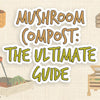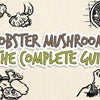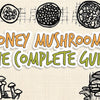Lobster Mushrooms: The Complete Guide
Lobster mushrooms have forever been one of the most respected dishes in the food industry. These mushrooms are unlike any others, making them very popular. They also don't just exist anywhere thus making them very hard to come by. This article will give you detailed information about them, where they are found, how to hunt for them, some of their best recipes, and an insight into why they look so bizarre.
Not Much Time? Skip To What You'd Like To Learn...
-
Top Facts
-
Variation of Lobster Mushrooms
-
Top 5 Benefits
-
How To Tell If Lobster Mushrooms Have Gone Bad
-
How To Pick and Identify Lobster Mushrooms
-
Why Are They So Expensive?
-
How To Grow Lobster Mushrooms At Home
-
Processing Lobster Mushrooms
-
How To Preserve Lobster Mushrooms
-
Lobster Mushroom Recipes
Top Facts

Photo Source: WildernessCollege
-
Lobster mushrooms are a very peculiar type of mushrooms that occur when a parasitic fungus called hypomyces attack a particular type of mushroom and deforms them. When the parasite takes over the mushroom the lobster-like shape is formed.
-
Their deep orange color and shape gives them their name.
-
They don't have gills, but instead, these incredible mushrooms come with pores that usually dot the surface when the lobsters reach maturity.
-
They are known to be very meaty with a shellfish aroma which can intensify once dried.
Variation of Lobster Mushrooms

Photo Source: AtlasObscura
Despite the fact that lobster mushrooms are known to come in a deep orange color, this is not always the case.
White Lobster Mushrooms: These are a disparity that come with a white coat. These are usually very difficult to come by. They are popular for their white color and have the same structure as that of the conventional lobsters. They, however, possess a different texture. During consumption, you will find that the texture of white lobsters is smoother than that of the orange ones. The other qualities are however similar. These white lobsters are also as a result of parasite hypomyces lactifluorum attacking the russula brevis or the lactarius piperatus.
Top 5 Benefits

Photo Source: WildernessCollege
Lobster mushrooms are known to harbor a number of benefits. They are known to be very nutritious, and this is because when growing they feed on other mushrooms thus getting nutrients from them.
Dietary Fiber - This is known to be one of the best forms of nutrients when it comes to assisting in food digestion. You will be able to keep constipation at bay without any side effects of taking medication (link).
Vitamin B - Lobster mushrooms have a large amount of vitamin B which is known to assist the immune system function as it is supposed to. It also supports one of the main organs in the body which is the heart and assists in breaking down blood sugars (link).
Zinc - Lobster mushrooms contain zinc which is known to be very good at promoting cell growth and facilitating wound healing.
Potassium - Potassium is also present in lobster mushrooms, which is responsible for regulating fluid balance, ensuring proper muscle contractions and enhances nerve signals.
Selenium - These mushrooms include selenium which is a remarkable mineral when it comes to preventing oxidation of the thyroid. It also ensures the proper production of the thyroid hormone.
(link)
How To Tell If Lobster Mushrooms Have Gone Bad
Just like any other food product, these mushrooms do go bad. Before cooking they usually have quite a lengthy lifespan. But immediately after cooking their lifespan shrinks exponentially.
These are some signs to look out for to tell if your mushrooms have gone bad:
Foul Smell - It is quite common that any food that has gone bad usually produces some type of foul smell. They are known to produce a very bad smell just like that of ammonia. Once this happens, do away with your lobster mushrooms.
Slimy Film - This is yet another common indication that your lobster mushrooms have gone bad. Once you see a slimy film on their surface, don't attempt cooking them, go right ahead and dispose of them. Consuming them may lead to a number of stomach complications that may end up persisting and could lead to a bigger medical issue.
Dark Color - Lobster mushrooms are known to have a very unique orange color. If they discolor or turn dark brown to black they cannot be consumed.
Mushy Texture - Good lobster mushrooms should have a rough texture that can be easily gripped. However, there are times when the texture is mushy and slippery. This means that your lobsters are ruined. You should thus feel the texture when preparing and once you notice they are mushy, dispose of them.
How To Pick and Identify Lobster Mushrooms

Photo Source: WildernessCollege
WARNING: Never pick or eat wild mushrooms unless under the strict guidance of an expert.
When foraging we would always recommend using mushroom knife for ease of use, and a clean cut. Interested in learning more about mushroom knives? Click Here For The Complete Guide To Mushroom Knives
Texture - Lobster mushrooms tend to have a dense texture. This is due to numerous reasons. One of the main reason is due to the pores that are usually on the surface. So make sure that you feel the texture before proceeding with their collection.
Color - You should go for the lobsters that are bright orange unless you are able to find white ones. Fresh and edible lobster mushrooms will always have that significant and unique pigment. If you find white lobsters, don't be afraid to pick them, these are usually very hard to come by, but they are naturally good and edible. Avoid ones with purple patches, they are not edible, and so they should never be collected.
Smell - Lobster mushrooms should have a nutty and sweet smell when fresh.
Shape - Just like their name suggests, lobster mushrooms possess the shape of a lobster. This is as a result of the parasite hypomyces. This parasite deforms the mushrooms shape into a lobster-like look thus making it very easy to identify the mushroom. The mushrooms have a minimum to no stem at all. This means that they tend to be very close to the soil thus collecting a lot of dirt from the ground.
Size - Lobsters always grow to a certain size range. This is usually between 15 cm to 20 cm. As mentioned above, they tend to have very small stems which sometimes are completely unavailable.
Why Are They So Expensive?
Lobster mushrooms are usually more expensive than the other mushrooms. They fetch a high price on the market and cannot be compared to others. Numerous reasons make them expensive for instance:
Region They Grow: Naturally, these mushrooms are very rare to come by. They only grow in certain regions that have specific conditions. Most of the regions they grow are those that usually have temperate forests as well as those regions with hemlock trees. They are known to exist commonly in the North American region. Their scarcity makes them more expensive.
Specific Growing Season: Lobster mushrooms are known to grow during specific seasons. To find them you will need to be on the lookout from the beginning of the summer up to mid-fall. This is usually from July to late October.
Unique Method of Harvesting: When picking lobster mushrooms, you need to be very cautious. Only the matured ones should be picked without disturbing those that are sprouting or those that are still young. This is because once they are disturbed during growth, they tend to have bad growth.
If you’re interested in our harvesting mushrooms, check out our Top 10 Mushroom Knives here (link).
How To Grow Lobster Mushrooms At Home

Photo Source: MDC
Cultivating lobster mushrooms does require being able to grow russula brevipe or lactarius piperatus. Once you have grown them, follow the steps below:
Requirements:
Low moisture
Compost
Sawdust
Straw or wood
Step 1.
Place your russula brevipes (short-stemmed russula) or lactarius piperatus (blancaccio) in a nutrient-rich media. This should be done in a clean environment.
Step 2.
Transfer the mycelium to a jar of sterilized grain and let it grow until it fills the jar.
Step 3.
Spawn the mushroom in the jar to different containers.
Step 4.
Inoculate them onto a compost material where they will be required to grow.
Step 5.
Once they have grown, introduce the hypomyces lactifluorum parasite which will transform the existing mushrooms into lobster mushrooms.
Step 6.
Wait for them to grow then harvest. Ensure that you keep the environmental conditions as advised.
Want to know our Top 10 Mushrooms Growing Kits? We have a full and comprehensive guide to the best growing kits and considerations before buying one too! Check out our Top 10 Mushroom Growing Kits Here.
Processing Lobster Mushrooms
Brush: Brush them gently with a mushroom or vegetable brush to do away with all the dirt. Some of them have cracks on their surface which are known to be storage spots for dirt so ensure to thoroughly clean this area.
Wiping: If the dirt is not removed using a brush, dampen a paper towel or cloth and wipe the mushrooms over.
Storage: Store them in full as this will increase their shelf life and place them in a cold environment as this will preserve them longer.
How To Preserve Lobster Mushrooms
Drying: Lobster mushrooms can be preserved by drying them completely to remove all the moisture.
For a comprehensive guide to drying lobster mushrooms, check out our article here (link).
Fridge or Freezer: Preserve them raw by storing them in the refrigerator. When cooked, ensure you keep them in a cool environment with the date you cooked included. This is because cooked mushrooms are only good for one or two days.
Interested in further ways to preserve mushrooms? Have a look at our article on freezing mushrooms here (link) and storing them here (link).
Lobster Mushroom Recipes
Lobster Mushroom Soup
Inspired by Edible Wild Food (link)
Ingredients:
3 carrots, diced
4 stalks of celery, diced
3 onions, chopped
8 cups chicken stock
2 large lobster mushrooms
1/4 cup uncooked rice
1 tsp turmeric powder
salt and pepper
hot sauce
Directions:
1. In a large soup pot, slowly boil soup stock.
2. Add carrots and celery.
3. In a skillet, fry onions in butter and add the soup mixture.
4. Add lobster mushrooms to the skillet and sauté for 8 minutes.
5. Add the onions and mushrooms to the soup mixture.
6. Add a cup of uncooked rice and season with turmeric, salt, and pepper.
7. Allow to cook for 45 minutes.
8. Serve hot.
Sautéed Mushrooms
Inspired by Tasting Table (link)
Ingredients:
2 garlic cloves, minced
1 shallot, pounded
1 tbsp butter
2 cups lobster mushrooms, diced
1 tsp thyme leaves, minced
ground nutmeg
salt and pepper
Directions:
1. Melt butter in a skillet over medium heat.
2. Add the shallot and garlic and fry for 3 minutes.
3. Add the mushrooms, nutmeg, and thyme. Season with salt and pepper.
4. Cook until they are tender.
5. Serve hot.
Lobster Mushrooms As A Side Dish
Inspired by Marx Food (link)
Ingredients:
2 tbsp butter
1 cups lobster mushrooms, diced
2 garlic cloves, minced
salt and pepper
Directions:
1. Heat the butter in a skillet until melted.
2. Add minced garlic and stir.
3. Add mushrooms then season with salt and pepper.
4. Sauté until tender.
Chinese Steamed Noodles
Inspired by Good Life Cooking (link)
Ingredients:
3 lobster mushrooms, diced
50g noodles
1.5 tbsp soy sauce
3 stalks green onion, diced
1 tbsp ginger, minced
olive oil
salt
Directions:
1. Add the noodles to a bowl and leave to soften. Strain noodles and set aside.
2. Mix together the ginger and mushrooms and season with a pinch of salt.
3. Add the noodles and mushroom mix to a steamer and allow to steam for 35 minutes.
4. Once steamed, heat a skillet over high heat and add olive oil
5. Add the ingredients from the steamer to the skillet, add soy sauce and sauté until hot.
6. Serve with chopped green onion.
Tofu and Lobster Mushroom Broth
Inspired by Fat Free Vegan (link)
Ingredients:
1 cup dried lobsters, diced
2 cups water
2 tbsp olive oil
1 tbsp ginger, minced
1 garlic clove, minced
2 tbsp soy sauce
1 tsp sugar
1 tbsp rice wine
8 oz cubed tofu
1 tbsp mellow white miso
Directions:
1. In a large pan simmer the mushrooms with the water for 30 minutes.
2. After 30 minutes, strain the water through a sieve, reserving 2 cups and remove the mushrooms.
3. Chop the mushrooms.
4. Add the oil into the pan and then all of the ingredients, except miso, and sauté.
In a bowl combine 1/4 cup water and miso and mix until it reaches a paste.
Turn the heat to low and add the paste to the pan.
Serve hot over noodles.







I’m trying to find somewhere where I can get some lobster mushroom spawn but I’m having trouble is there a reason why places don’t sell it? Or do you know anywhere that does sell them? Thank you